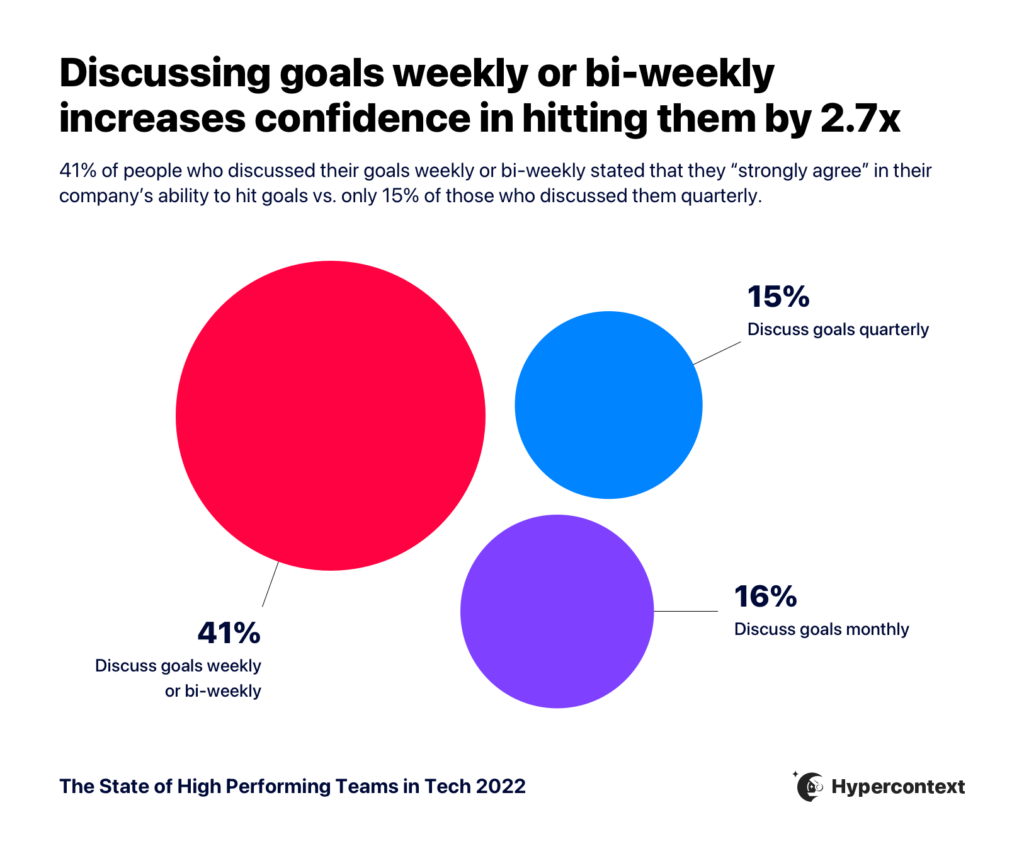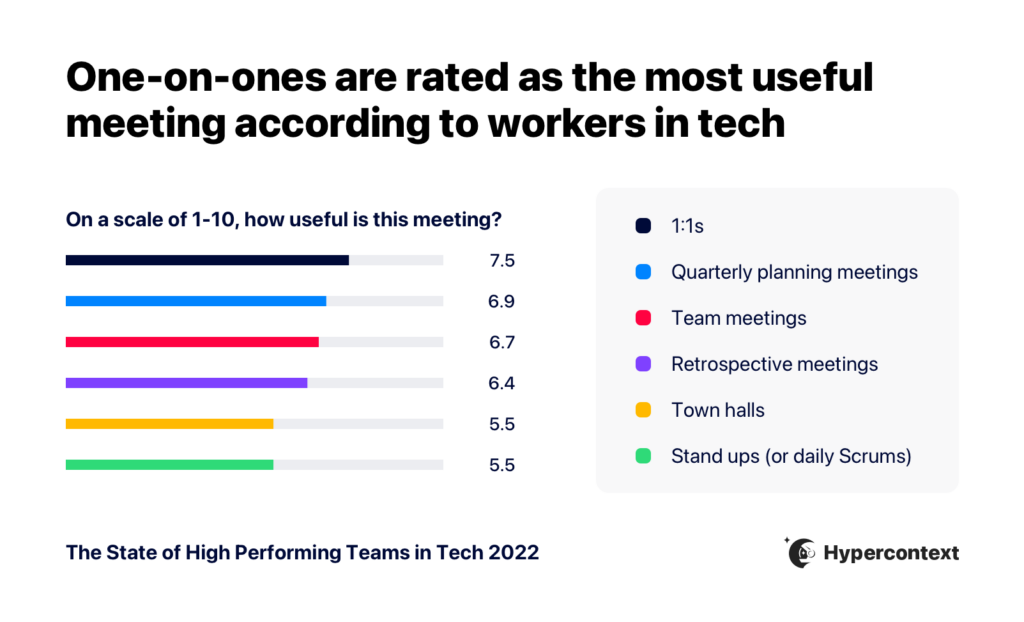Managers play a huge role in motivating and engaging their employees, but their challenges are often overlooked.
But what are managers’ biggest challenges? And what skills do they need to work on to become better leaders?
…Who better to ask than their direct reports!
We asked 490 people the single biggest area where their manager needs to improve. Then, Hypercontext’s CEO and Co-Founder Brennan McEachran and Head of CS and Sales, Jocelyn Brown, did a deep dive into how to tackle these management challenges in a recent live session.
Challenge 1: Clear vision/strategy for the team
Having a clear vision and strategy is the single biggest management challenge.
24% of people cited it as the single biggest area where their manager needs improvement.
Why does it matter?
The importance of goals is hard to understate. 59% of people agree clear goals and expectations is the number one factor impacting productivity.
Clear goals and expectations give employees a sense of direction and belonging, leading to higher productivity.
Not only does it impact individual performance, but there’s also a correlation between clear goals and company performance. People who don’t know their goals are over 3X more likely to work at a company that’s shrinking in revenue than those who know them.

Tips for developing a clear vision and strategy
Developing a strategy and vision seems like a big skill to perfect. But it doesn’t need to be difficult. Let’s take a look at some actionable ways to improve vision and strategy through goal-setting.
Set up a quarterly goal-setting meeting with your team
You don’t need to have all the answers. Instead of goal-setting being a top-down activity, make it collaborative. It’s not only on you to set the goals and share them. Your job is to understand and communicate: what are the company goals and why? Then, take the input from the team on how to get there.
This will be helpful in a number of ways. Firstly, you don’t know everything. Your team can bring rich information to the table to help inform the goals you set.
Challenge 2: Communicating well
15% of people think their managers need to improve how they communicate.
Why does it matter?
40% of people agree great team communication is one of the top factors leading to productivity at work.
Goal-setting is a great example of the importance of communication. You can set amazing goals, but if they’re not properly communicated, it won’t matter.
Tips for improving communication
There’s no one size fits all solution for better communication. Everyone has different communication styles — some prefer asynchronous work, some prefer consistent real-time interaction, some thrive on interruption and some need extended focus time.
Your job as a manager is to listen to what your team needs and prefers when it comes to communication. Here are a few things you can do to improve communication practices:
Understand communication preferences

Firstly, get an understanding of how everyone wants to communicate and collaborate, and set expectations from the start.
With only 3% of people returning to fully in-person work, it’s important to understand the best way to communicate with your distributed team.
An important thing to take into consideration here is the maker vs. manager schedule. While managers do a lot of their work through meetings, their direct reports often need longer periods of uninterrupted focus time to get things done. Even a 15-minute meeting in the middle of a two-hour window can completely derail productivity for a ‘maker.’
Challenge 3: Supporting career development and performance
14% of people agree their manager needs to improve how they support career development and performance. And managers themselves agree— 15% of managers find it to be their single biggest management challenge.
Why does it matter?
17% of people who applied for a new job in the last 6 months cited ‘not enough growth opportunities as the primary reason. And according to a recent study by Lever, nearly half of employees who plan to stay at their company will ask for a role change in 2022.
Growth is a huge motivator. Without a clear path for growth, it’s easy to get complacent or unhappy in your role.
While it may not be in the manager’s direct control when an opportunity for advancement is available, they can help team members prepare for the opportunity by supporting their growth and helping identify what they might want in their career. This includes understanding how your reports want to grow and providing the opportunities for them to do so.
Challenge 4: Empowering the team (not micromanaging)
No one wants to micromanage. We all know it’s bad, and most often managers aren’t doing it on purpose. Regardless, it’s a common management challenge.
What’s refreshing to note is that managers know they’re doing it and want to stop.
While 10% of direct reports think their managers micromanage, 20% of managers feel it’s their biggest challenge.

Why does it matter?
Micromanaging stifles growth and creates a toxic environment. If you don’t trust your team, things won’t get done. Your team becomes scared to think outside the box and to take ownership over the work.
In short, it’s not a problem you want to have.
Tips for empowering your team
Micromanaging typically stems from a lack of trust and fear. To help let go of projects and empower your team, here are the two most important things you can do:
Create accountability on your team
Create accountability by encouraging your team to take ownership of their work. If your team members feel like you’re constantly swooping in to change and comment on every little thing, they’re going to stop trying as hard. A great way to get out of the driver’s seat and stop micromanaging is by having them own the accountability.
What does this mean?
Set the expectation that they’ll bring things to you when they need feedback, rather than you jumping in at random times in the day.
We like to use the 10-50-99 rule. This rule takes into account the stage of a project when giving feedback. For example, when something’s 10% done, it requires different feedback than it does at the 99% done stage. And when someone gets 10% feedback for a project that’s 99% done, that’ll cause frustration.
Challenge 5: Being a good coach
As Jocelyn put it, “when you’re trying to achieve something great, you turn to a coach.” Whether it be through sports, through work, or through your personal life.
9% of people think their manager needs to improve their coaching abilities.
Why does it matter?
56% of people agree fulfilling/challenging work is a top factor impacting motivation.
If your team members already know how to do everything they’re working on , they’re not going to be as motivated and engaged. People crave a challenge.

And with challenging work, comes the need for learning and, in turn, coaching.
Tips for coaching your team
Coaching is about helping your team grow by sharing knowledge and experience. And that’s not only limited to your own knowledge.
Sometimes, you’re not an expert in the function you’re managing. That’s okay. Giving practical or technical advice isn’t the main part of coaching. Instead:
Listen to where they want help
The first step to good coaching is listening. Don’t make assumptions based on where you think they need improvement.
What does your direct report want to learn? Where do they need support?
Understanding the answers to these questions will also help you get a grasp of how you can help push their careers forward. A great time to do this is in your 1:1s.
Ask simple questions like, “where do you see yourself in 1 year?” or “where do you need support?”









Replies to This Discussion